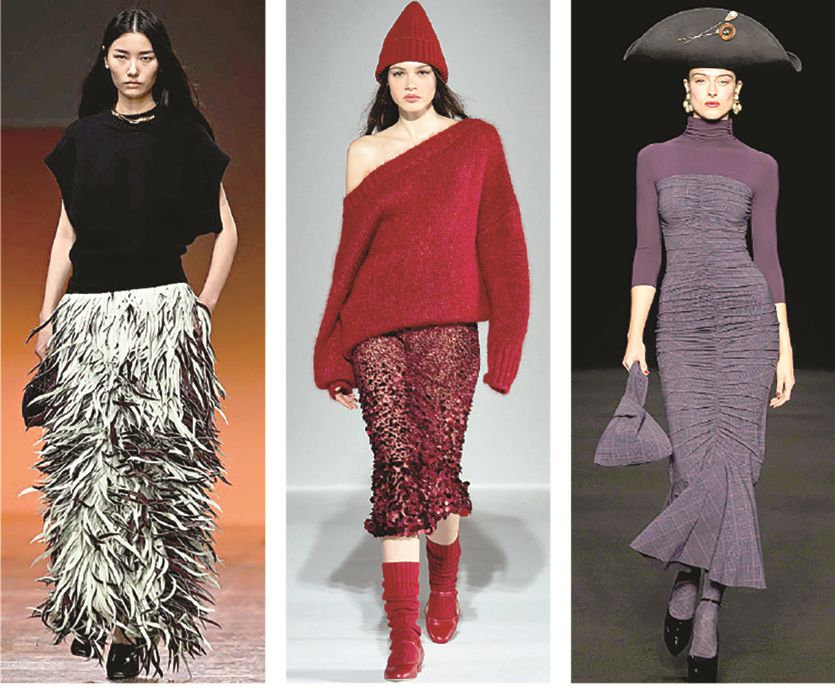Listen to the audio version of the article
«Winter flowers don’t exist in nature: I invented them», says Giorgio Armani smiling at the end of the fashion show which closed the short but intense Milan fashion week on Sunday. A particularly rigorous edition, from an aesthetic point of view: not very exuberant, marked by a sobriety not at all inclined to risk, if anything tending towards the dark, certainly conservative: the difficulties of the market and the certainly not peaceful world climate have an influence. More and more romantic as the years pass, but never saccharine, Armani joins the contingent of those who preach kindness as an antidote to dark times. The collection is a treatise on soft resistance to desperation, despite being largely dyed in midnight blue and black, because, Armani unwaveringly states, “black is a wonderful color that suits everyone”. However, his is a luminous black, lit up by the lustrous flashes of the velvet, punctuated by the colors of the flowers that rest on everything together with embroideries of dragonflies. «A message of hope and respect for the environment», he continues, also promoting the Milan week; he sent a letter to the Chamber of Fashion asking for an extra day. Hope, care for the environment but still and always an idea of style, which kindly accompanies the person, who evolves coherently. From soft tailoring to oriental echoes, there is everything Armani in this new try, with a pictorial softness that is of today.
The Loro Piana collection is soft and enveloping, a brand that has always been linked to Italian textile excellence but until now relegated to the niche of connoisseurs and scholars. The long wave of quiet luxury has instead made it a must, attracting attention which is however managed with the usual discretion. That is, Loro Piana courts fashion, but does so from afar, with precision and poetry, and the result is ineffable.
At Bottega Veneta, Matthieu Blazy thinks about everyday life, which he munumentalizes with abstract volumes, precious materials, refined craftsmanship. It is one of his best tests for the brand: move in expression – since the beginning of the mandate, Blazy insists on creating shows which, due to the apparently inconsistent variety of the characters that populate them and what they wear, imitate the varied humanity of a street or a square – but tense and direct; high in tone but finally free from virtuosity that risked appearing cloying. It’s the beginning of a promising path: if it lightened up even more – some looks actually had a monumental volume and solemnity – Blazy would truly manage to strike a unique chord, to modernize the artisanal aspect, to create a new version of luxury Italian.
Gabriele Colangelo, from Giada, an Italian brand owned by China, remains faithful to an idea of absolute purity which, however, increasingly acquires sensuality. He too is a virtuoso of workmanship. In this round, the very light leathers made transparent by tiny carvings are the perfect expression of a taste made of subtractions but not sacrifices, purified of the essence and yet vibrant. Andrea Adamo is another herald of degree zero: he imagines clothes as a second skin, which also have the colors of the skin, in an idea of clothed nudity that is full of character. At Luisa Spagnoli we work on an idea of seduction that is naive and spontaneous. The models wear flat shoes with straps and large ribbed socks, with a colored wool hat on their heads; the legs, however, are bare, uncovered by short hems. It is a test full of charm, with the concreteness of the product – the knitwear is very carefully crafted, as is the tailoring – which is the reason for its lasting success among a transversal audience.
Chiara Boni, finally, recalls the Sixties of Biba and London in which all social classes mixed in a liberating and never-seen swinging. She does so in the wake of her personal memories, already recalled in a recently published autobiography, recounting the encounter with her style as a rebellion on the part of a well-mannered young Italian. The collection retains that spirit, and is perhaps more Vivienne Westwood than Biba, with an entirely Italian taste for beauty.
